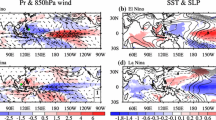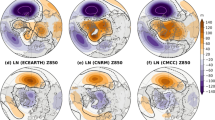Abstract
El Niño–Southern Oscillation (ENSO) events significantly affect the year-by-year variations of the East Asian winter monsoon (EAWM). However, the effect of La Niña events on the EAWM is not a mirror image of that of El Niño events. Although the EAWM becomes generally weaker during El Niño events and stronger during La Niña winters, the enhanced precipitation over the southeastern China and warmer surface air temperature along the East Asian coastline during El Niño years are more significant. These asymmetric effects are caused by the asymmetric longitudinal positions of the western North Pacific (WNP) anticyclone during El Niño events and the WNP cyclone during La Niña events; specifically, the center of the WNP cyclone during La Niña events is westward-shifted relative to its El Niño counterpart. This central-position shift results from the longitudinal shift of remote El Niño and La Niña anomalous heating, and asymmetry in the amplitude of local sea surface temperature anomalies over the WNP. However, such asymmetric effects of ENSO on the EAWM are barely reproduced by the atmospheric models of Phase 5 of the Coupled Model Intercomparison Project (CMIP5), although the spatial patterns of anomalous circulations are reasonably reproduced. The major limitation of the CMIP5 models is an overestimation of the anomalous WNP anticyclone/cyclone, which leads to stronger EAWM rainfall responses. The overestimated latent heat flux anomalies near the South China Sea and the northern WNP might be a key factor behind the overestimated anomalous circulations.
Similar content being viewed by others
References
Adler, R. F., G. J. Huffman, A. Chang, et al., 2003: The version-2 Global Precipitation Climatology Project (GPCP) monthly precipitation analysis (1979–present). J. Hydrometeor., 4, 1147–1167.
An, S.-I., and F.-F. Jin, 2004: Nonlinearity and asymmetry of ENSO. J. Climate, 17, 2399–2412.
An, S.-I., Y. G. Ham, J. S. Kug, et al., 2005: El Niño–La Niña asymmetry in the coupled model intercomparison project simulations. J. Climate, 18, 2617–2627, doi: 10.1175/JCLI 3433.1.
Burgers, G., and D. B. Stephenson, 1999: The “normality” of El Niño. Geophys. Res. Lett., 26, 1027–1030.
Chang, C.-P., Z. Wang, and H. Hendon, 2006: The Asian winter monsoon. The Asian Monsoon. Wang, B., ed. Berlin Heidelberg, Springer, 89–127.
Chen, W., H.-F. Graf, and R. H. Huang, 2000: The interannual variability of East Asian winter monsoon and its relation to the summer monsoon. Adv. Atmos. Sci., 17, 46–60.
Duchon, C. E., 1979: Lanczos filtering in one and two dimensions. J. Appl. Meteor., 18, 1016–1022.
Hoerling, M. P., A. Kumar, and M. Zhong, 1997: El Niño, La Niña, and the nonlinearity of their teleconnections. J. Climate, 10, 1769–1786.
Ji, L. R., S. Q. Sun, K. Arpe, et al., 1997: Model study on the interannual variability of Asian winter monsoon and its influence. Adv. Atmos. Sci., 14, 1–22.
Jin, F.-F, S.-I. An, A. Timmermann, et al., 2003: Strong El Niño events and nonlinear dynamical heating. Geophys. Res. Lett., 30, doi: 10.1029/2002GL016356.
Kalnay, E., M. Kanamitsu, R. Kistler, et al., 1996: The NCEP/NCAR 40-year reanalysis project. Bull. Am. Meteor. Soc., 77, 437–472.
Kang, I.-S., and J.-S. Kug, 2002: El Niño and La Niña sea surface temperature anomalies: Asymmetry characteristics associated with their wind stress anomalies. J. Geophys. Res., 107, ACL 1-1–ACL 1-10, doi: 10.1029/2001JD000393.
Li, C. Y., 1990: Interaction between anomalous winter monsoon in East Asia and El Niño events. Adv. Atmos. Sci., 7, 36–46.
Song, F. F., and T. J. Zhou, 2014: The climatology and interannual variability of East Asian summer monsoon in CMIP5 coupled models: Does air–sea coupling improve the simulations? J. Climate, 27, 8761–8777.
Tomita, T., and T. Yasunari, 1996: Role of the northeast winter monsoon on the biennial oscillation of the ENSO/monsoon system. J. Meteor. Soc. Japan, 74, 399–413.
Wang, B., R. G. Wu, and X. H. Fu, 2000: Pacific–East Asian teleconnection: How does ENSO affect East Asian climate? J. Climate, 13, 1517–1536.
Wang, L., W. Chen, and R. H. Huang, 2008: Interdecadal modulation of PDO on the impact of ENSO on the East Asian winter monsoon. Geophys. Res. Lett., 35, L20702, doi: 10.1029/2008-GL035287.
Webster, P. J., V. O. Magaña, T. N. Palmer, et al., 1998: Monsoons: Processes, predictability, and the prospects for prediction. J. Geophys. Res., 103, 14451–14510.
Wu, B., T. Li, and T. J. Zhou, 2010: Asymmetry of atmospheric circulation anomalies over the western North Pacific between El Niño and La Niña. J. Climate, 23, 4807–4822, doi: 10.1175/2010JCLI3222.1.
Wu, R. G., and B. P. Kirtman, 2005: Roles of Indian and Pacific Ocean air–sea coupling in tropical atmospheric variability. Climate Dyn., 25, 155–170.
Wu, R. G., Z.-Z. Hu, and B. P. Kirtman, 2003: Evolution of ENSO- related rainfall anomalies in East Asia. J. Climate, 16, 3742–3758.
Xie, P. P., and P. A. Arkin, 1997: Global precipitation: A 17-year monthly analysis based on gauge observations, satellite estimates, and numerical model outputs. Bull. Amer. Meteor. Soc., 78, 2539–2558.
Zhang, R. H., A. Sumi, and M. Kimoto, 1996: Impact of El Niño on the East Asian monsoon: A diagnostic study of the’ 86/87 and’ 91/92 events. J. Meteor. Soc. Japan, 74, 49–62.
Zhang, R. H., A. Sumi, and M. Kimoto, 1999: A diagnostic study of the impact of El Niño on the precipitation in China. Adv. Atmos. Sci., 16, 229–241.
Zhang, R. H., T. R. Li, M. Wen, et al., 2015: Role of intraseasonal oscillation in asymmetric impacts of El Niño and La Niña on the rainfall over southern China in boreal winter. Climate Dyn., 45, 559–567.
Author information
Authors and Affiliations
Corresponding author
Additional information
Supported by the National Natural Science Foundation of China (41405103 and 41125017), China Meteorological Administration Special Public Welfare Research Fund (GYHY201506012), and Joint Center for Global Change Studies (105019).
Rights and permissions
About this article
Cite this article
Guo, Z., Zhou, T. & Wu, B. The asymmetric effects of El Niño and La Niña on the East Asian winter monsoon and their simulation by CMIP5 atmospheric models. J Meteorol Res 31, 82–93 (2017). https://doi.org/10.1007/s13351-017-6095-5
Received:
Accepted:
Published:
Issue Date:
DOI: https://doi.org/10.1007/s13351-017-6095-5




